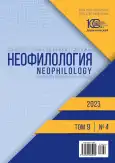Screen communication in the context of the video essay genre
- Авторлар: Mashaev M.S.1, Bazanova A.E.1
-
Мекемелер:
- Peoples’ Friendship University of Russia named after Patrice Lumumba
- Шығарылым: Том 9, № 4 (2023)
- Беттер: 959-969
- Бөлім: МЕДИАКОММУНИКАЦИИ
- URL: https://journal-vniispk.ru/2587-6953/article/view/295791
- DOI: https://doi.org/10.20310/2587-6953-2023-9-4-959-969
- ID: 295791
Дәйексөз келтіру
Толық мәтін
Аннотация
We studied the meaning of the screen as an intermediary between the author of a visual essay and his audience in the modern online space. The origins and features of the genre, which originated from the printed essay, are analyzed. We consider the types of videos, as well as the verbal and non-verbal methods used in them to convey information to the viewer. It has been established that the widespread use of the global network and multimedia technologies opens up opportunities for content creators to increase the user base and increase its involvement. New ways of designing broadcast information messages are emerging. The advent of electronic devices is facilitating the discovery of new ways of presenting information and interacting with audiences that were not previously possible in the traditional printed genres of film criticism. Modern software and technologies allow a wide range of authors to use editing as an effective method for explaining the thesis chosen for their work. Visual images have acquired a dominant role in presenting material. Social networks and comment sections on popular video hosting sites allow you to receive feedback from viewers, and also create a previously impossible connection between a film critic and his audience. The results of the study can be used by scientists in the field of mass communication, journalism and film criticism.
Негізгі сөздер
Авторлар туралы
M. Mashaev
Peoples’ Friendship University of Russia named after Patrice Lumumba
Email: 1042210126@pfur.ru
ORCID iD: 0000-0002-9358-541X
Post-Graduate Student
6 Miklukho-Maklaya St., Moscow, 117198, Russian FederationA. Bazanova
Peoples’ Friendship University of Russia named after Patrice Lumumba
Хат алмасуға жауапты Автор.
Email: bazanova_ae@pfur.ru
ORCID iD: 0000-0001-5560-5953
PhD (Philology), Associate Professor of Theory and History of Journalism Department
6 Miklukho-Maklaya St., Moscow, 117198, Russian FederationӘдебиет тізімі
- Babeshko M.O. Features of screen communications in computer games. Ekonomika i sotsium = Economic and Society, 2019, no. 10 (65), pp. 496-499. (In Russ.) https://elibrary.ru/mxjbug
- Volkova I.I. Video games and new media: game approach to communications within virtual space. Vestnik RUDN. Seriya: Literaturovedenie. Zhurnalistika = RUDN Journal of Studies in Literature and Journalism, 2017, vol. 22, no. 2, pp. 312-320. (In Russ.) https://doi.org/10.22363/2312-9220-2017-22-2-312-320, https://elibrary.ru/zewenb
- McWhirter A. Film criticism, film scholarship and the video essay. Screen, 2015, vol. 56, issue 3, pp. 369-377. https://doi.org/10.1093/screen/hjv044
- Keathley C. La caméra-stylo: Notes on cinematography and cinephilia. The Language and Style of Film Criti-cism. New York, Routledge Publ., 2011, pp. 176-191.
- Turkgeldi K. Thinking of video essays as a performative research with a new concept: transimage. SineFilozofi, 2021, vol. 6, issue 11, pp. 812-825 https://doi.org/10.31122/sinefilozofi.823234
- Gürkan İ. Film çalışmalarında eleştirinin dönüşümü: görsel-işitsel denemeler (audiovisual essay). Sinefilozofi, 2019, no. 4 (8), pp. 284-303. (In Tur.) https://doi.org/10.31122/sinefilozofi.633100
- Sendra E. Video essays: curating and transforming film education through artistic research. International Jour-nal of Film and Media Arts, 2020, vol. 5, no. 2, pp. 65-81. https://doi.org/10.24140/ijfma.v5.n2.04
- Glazkova E.A. Hybrid genres of motion pictures and video essays in motion pictures continuum: history, specifics and perspectives. Universitetskii nauchnyi zhurnal = Humanities and Science University Journal, 2016, no. 20, pp. 234-243. (In Russ.) https://elibrary.ru/widjqv
- Tikhonova Yu.V. Genre of essay in its present-day expression. Vestnik Moskovskogo gosudarstvennogo lingvis-ticheskogo universiteta. Gumanitarnye nauki = Vestnik of Moscow State Linguistic University. Humanities, 2017, no. 19 (758), pp. 69-79. (In Russ.) https://elibrary.ru/nfojil
- Mirnenko M.A. Ekrannaya kommunikatsiya v sovremennom mediaprostranstve [Screen communication in the modern media space]. Sbornik statei 5 Mezhdunarodnoi nauchno-prakticheskoi konferentsii «Yazyk i rech’ v Internete: lichnost’, obshchestvo, kommunikatsiya, kul’tura»: в 2 t. [Proceedings of the 5th International Scien-tific and Practical Conference “Language and Speech on the Internet: Personality, Society, Communication, Culture”: in 2 vol.]. Moscow, Peoples’ Friendship University of Russia named after Patrice Lumumba Publ., 2021, vol. 2, pp. 125-128. (In Russ.) https://elibrary.ru/eyjaym
- Grant S. The audiovisual essay as performative research. NECSUS European Journal of Media Studies, 2016, vol. 5, no. 2, pp. 255-265. https://doi.org/10.25969/mediarep/3370
- McWhirter A. Film criticism in the twenty-first century. Journalism Practice, 2015, vol. 9, issue 6, pp. 890-906. https://doi.org/10.1080/17512786.2015.1051372
Қосымша файлдар










